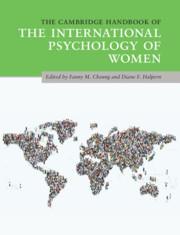Book contents
- The Cambridge Handbook of the International Psychology of Women
- The Cambridge Handbook of the International Psychology of Women
- Copyright page
- Dedication
- Contents
- Figures
- Tables
- Contributors
- Acknowledgments
- Section 1 The Underpinnings of Sex and Gender and How to Study Them
- Section 2 Developmental Perspectives of the International Psychology of Women
- Section 3 Cognitive and Social Factors
- Section 4 Work and Family Issues
- Section 5 Inequality and Social Justice
- Section 6 Health and Well-Being
- 31 Happiness across Cultures and Genders
- 32 Women under Pressure
- 33 Gender and Women’s Sexual and Reproductive Health
- 34 Physical Health
- 35 Women and Suicidal Behavior
- 36 Sex and Gender in Psychopathology
- 37 Women and Psychotherapy
- Epilogue Some Final Thoughts and Take-Home Messages
- Index
- References
35 - Women and Suicidal Behavior
Paradigm-Shift Lessons from China
from Section 6 - Health and Well-Being
Published online by Cambridge University Press: 20 July 2020
- The Cambridge Handbook of the International Psychology of Women
- The Cambridge Handbook of the International Psychology of Women
- Copyright page
- Dedication
- Contents
- Figures
- Tables
- Contributors
- Acknowledgments
- Section 1 The Underpinnings of Sex and Gender and How to Study Them
- Section 2 Developmental Perspectives of the International Psychology of Women
- Section 3 Cognitive and Social Factors
- Section 4 Work and Family Issues
- Section 5 Inequality and Social Justice
- Section 6 Health and Well-Being
- 31 Happiness across Cultures and Genders
- 32 Women under Pressure
- 33 Gender and Women’s Sexual and Reproductive Health
- 34 Physical Health
- 35 Women and Suicidal Behavior
- 36 Sex and Gender in Psychopathology
- 37 Women and Psychotherapy
- Epilogue Some Final Thoughts and Take-Home Messages
- Index
- References
Summary
An often-cited finding in US-driven suicidology is that women have higher rates of suicidal behavior, and lower suicide rates than men. This pattern, however, is not representative of the global suicidality picture. In Asian countries, female and male suicide rates are similar. To stimulate new thinking about female suicidality, we put China at the center of our analysis, and the United States at the periphery, and then discussed the insights generated by this reversal. Insights include that the US-centered canon is caught in the mental illness paradigm; and that it generalizes to women assumptions and evidence that mainly apply to men. For example, China’s data challenge dominant assumptions that marriage offers suicide protection. For many Chinese rural women, suicide is an act of despair and protest against suffocating marriages and communities – not a plea for closer ties (nor an expression of mental illness). China’s evidence, including that women’s suicide-mortality has significantly dropped since urbanization, supports a paradigm-shift in suicidology.
- Type
- Chapter
- Information
- The Cambridge Handbook of the International Psychology of Women , pp. 497 - 513Publisher: Cambridge University PressPrint publication year: 2020
References
Suggested Readings

Silvia Sara Canetto is Professor of Psychology at Colorado State University, Fort Collins, USA. She was born, raised, and educated in Italy where all her family still reside, and spent four years in Israel, where she received her MA in General Psychology from the Hebrew University of Jerusalem. She got her Doctor of Physiological Psychology from University of Padova, Italy, before completing her doctoral degree in Clinical Psychology and Gerontology from Northwestern University, USA. She is now an American as well as an Italian citizen. The United States is the exotic site of her critical studies of dominant “White” culture, and one of her homes. She speaks with an accent every language she knows: English, French, Spanish, Hebrew, and her native Italian, which makes her a stranger and a bit at home in a lot of places. Her research focuses on cultural scripts of gender and suicidal behavior, and on cultural scripts of gender, science, and engineering. She also investigates and writes about women’s human rights. She is a Fellow of the American Psychological Association (APA), the Association for Psychological Science, and the Gerontological Society of America; and the recipient of APA’s Denmark-Reuder award for outstanding international contributions to the psychology of women and gender.

Jiashun Chen is a graduate student in the School of Psychology at South China Normal University, Guangzhou. He was born in Guangxi Zhuang Autonomous Region, although he belongs to the majority Han ethnic group. He speaks three Chinese dialects fluently and has been learning English for twelve years. Having grown up in China, he brings insider perspectives to the Chinese experiences addressed in this chapter. Chen was a short-term scholar at Colorado State University, Fort Collins, USA, with mentorship by Professor Silvia Sara Canetto. During his time at CSU, he took her graduate class on women, men, and gender, and collaborated with her research team on a study of scripts of gender and suicide in China. These experiences expanded his view of gender, sexualities, culture, class, and beyond, scientifically and personally. His volunteer experience at LGBTQ+ NGOs in Guangzhou contributed to his understanding and commitment to preventing prejudice and marginalization.



